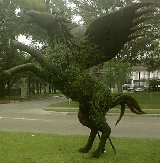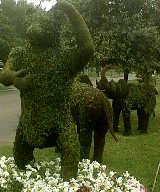Topiary
Today, a man brings animals to life. The University of Houston's College of Engineering presents this series about the machines that make our civilization run, and the people whose ingenuity created them.
My wife goes into a flower shop to look at plants. I wander out back. I see a stag on a table under a tree. He's made from welding rods. His head dips gracefully. A few deft strokes in bent steel tell his grace and timidity.
A man finishes welding a brace of concrete reinforcing steel as I walk up. He pushes back his mask and greets me. He's Juan Macario; young -- recently from Guatemala. I admire his work, so he tells me about it.
This is a form of topiary. When he finishes the frame, someone else will fill in the surface with wet moss -- then tie it down with plastic fish line. Finally you plant creeping ivy in the moss. One day this green feral beast will stand just beyond the trees at the edge of your yard, sniffing the open ground.
Topiary is the ancient art of trimming hedges into fantastic shapes. Pliny the Elder told about topiary in the reign of Caesar Augustus. Here in Houston, ivy on shaped frames is a form of topiary that's been booming since 1985.
At first the figures were stiff, and the range limited. Then it expanded -- horses and giraffes, monkeys and elephants. Macario shows me an eagle he made. The wings are spread in takeoff position. The claws grasp a fish.
"How do you do it?" I wonder. "Are you a trained sculptor?" "No," he says, stroking the ivied flank of a great snorting green bull, "But I like animals." It turns out he's only done this for a few months. He pulls out a looseleaf notebook.
He photocopies animal pictures and studies their motion. Then, with an eerie sense of shape, he bends welding rods into sentient forms. These creatures cost anywhere from 95 to 4000 dollars. But I don't read money in Juan's face. I read enchantment -- with the animals, with the subtlety of their movement.
Topiary became very popular in the 15th century. Renaissance artists were enchanted with shape and form -- not of animals, but of geometry. Wealthy garden owners cut shrubbery into mazes and puzzles. They wove their hedges into geometrical tapestries.
Now, in 20th-century Houston, the fascination is with animals. I go into the store and talk with the manager. Yes, he agrees, Macario has a talent. And the owner of the shop is an engineer. He likes to build things and to see things being built.
So it is self-expression that drives this small exercise in free enterprise. I might've doubted that as I drove in. But I glance at the angled leg of a deer as I leave. And I know Macario is telling me how to feel what they feel -- all the lovely beasts who complete the world we live in.
I'm John Lienhard, at the University of Houston, where we're interested in the way inventive minds work.
(Theme music)
Clevely, A.M., Topiary: The Art of Clipping Trees and Ornamental Hedges. Topsfield, Mass.: Salem House Publishers, 1988.
The florist we visited was The Flower Corner, 2501 W. Holcombe, Houston, TX 77030, Rudi Yeroshalmi, Manager (713-660-0666).
I took the following photos at the River Oaks Flower House several years after I wrote this episode. For a full-size image click on the thumbnail of the image.



